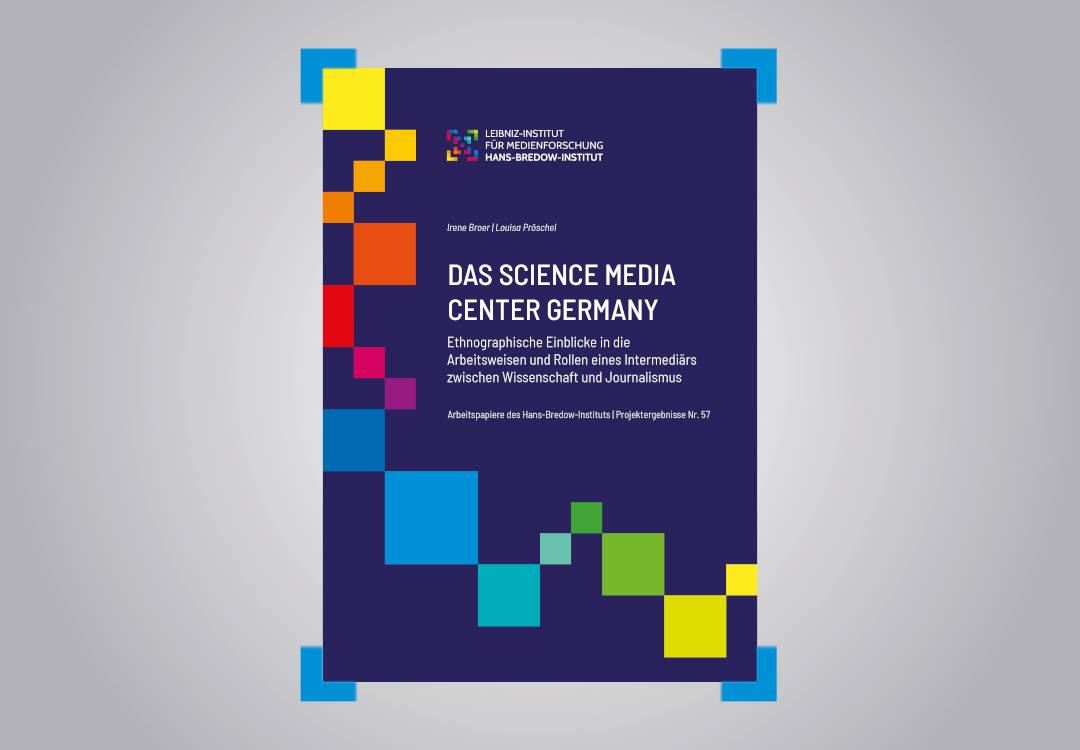

Irene Broer and Louisa Pröschel took a closer look at the Science Media Center Germany and its role between science and journalism. The findings of their ethnographic study are now available for download as No. 57 in the series "Arbeitspapiere des Hans-Bredow-Instituts [Working Papers of the Hans-Bredow-Institut]".
Broer, Irene; Pröschel, Louisa (2021): Das Science Media Center Germany: Ethnographische Einblicke in die Arbeitsweisen und Rollen eines Intermediärs zwischen Wissenschaft und Journalismus [The Science Media Center Germany. Ethnographic Insights into the Work and Roles of an Intermediary between Science and Journalism. Hamburg: Verlag Hans-Bredow-Institut, June 2021 (Arbeitspapiere des Hans-Bredow-Instituts | Projektergebnisse Nr. 57), DOI: https://doi.org/10.21241/ssoar.73542, ISBN 978-3-87296-169-3 (pdf)
As part of the BMBF joint project "MeWiKo – Media and Scientific Communication", which examines the impact of science journalistic reporting on the intra-scientific impact of publications, a four-week editorial ethnography was conducted in January 2020 at the Science Media Center Germany (SMC) based in Cologne. During this ethnography, which was particularly interested in the role and structure of the intermediary organisation, the first cases of COVID-19 were detected in Europe. This unpredictable development led to a follow-up ethnography being conducted in October 2020 focusing on developments in the SMC-newsroom since the beginning of the pandemic. The dataset from both ethnographies contains 28 interviews, 42 field notes, 168 SMC publications. The main findings are summarized below:

Irene Broer and Louisa Pröschel took a closer look at the Science Media Center Germany and its role between science and journalism. The findings of their ethnographic study are now available for download as No. 57 in the series "Arbeitspapiere des Hans-Bredow-Instituts [Working Papers of the Hans-Bredow-Institut]".
Broer, Irene; Pröschel, Louisa (2021): Das Science Media Center Germany: Ethnographische Einblicke in die Arbeitsweisen und Rollen eines Intermediärs zwischen Wissenschaft und Journalismus [The Science Media Center Germany. Ethnographic Insights into the Work and Roles of an Intermediary between Science and Journalism. Hamburg: Verlag Hans-Bredow-Institut, June 2021 (Arbeitspapiere des Hans-Bredow-Instituts | Projektergebnisse Nr. 57), DOI: https://doi.org/10.21241/ssoar.73542, ISBN 978-3-87296-169-3 (pdf)
As part of the BMBF joint project "MeWiKo – Media and Scientific Communication", which examines the impact of science journalistic reporting on the intra-scientific impact of publications, a four-week editorial ethnography was conducted in January 2020 at the Science Media Center Germany (SMC) based in Cologne. During this ethnography, which was particularly interested in the role and structure of the intermediary organisation, the first cases of COVID-19 were detected in Europe. This unpredictable development led to a follow-up ethnography being conducted in October 2020 focusing on developments in the SMC-newsroom since the beginning of the pandemic. The dataset from both ethnographies contains 28 interviews, 42 field notes, 168 SMC publications. The main findings are summarized below:
2021